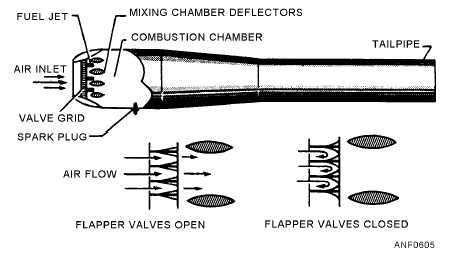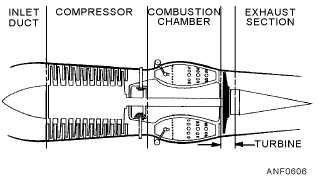mechanical), a combustion chamber, and a tailpipe or
exit nozzle, as shown in figure 6-5.
While the ramjet will deliver no static thrust, the
pulsejet engine can produce static thrust. However, the
thrust developed under static conditions is not sufficient
to enable a pulsejet aircraft or guided missile to take off
under its own power, at least not on conventional
runways. Consequently, missiles or other devices
powered by pulsejet engines must be boosted to
self-sustaining flight speeds by catapults or rockets.
Possible applications for the pulsejet engine, other
than for powering pilotless military weapons, include
flight research, powering helicopters by attaching small
pulsejet engines to the rotor blade tips, and emergency
power plants for small aircraft and gliders.
GAS TURBINE ENGINES
As stated earlier, there are four types of gas turbine
engines: turbojet, turboprop, turboshaft, and turbofan.
Each of these engines is briefly discussed in the
following paragraphs.
Turbojet Engines
There are over 40 different Navy models of the
turbojet engine. The A-6 and T-2 are examples of
aircraft that use this direct thrust engine. The turbojet
engine consists of five major components:
an inlet
duct,
a
compressor,
a
combustion
chamber
(or
chambers), a turbine (or turbines), and an exhaust cone
assembly, as shown in figure 6-6.
INLET DUCT.—The inlet duct is an opening in
the front of the aircraft that allows outside (ambient) air
to enter the engine. The compressor compresses the
incoming air and delivers it to the combustion (or
burner) section. In the combustion chamber, fuel is
sprayed into and mixed with the compressed air. An
igniter then ignites the fuel-air mixture. The burning
mixture continues to burn in the presence of the proper
fuel-air mixture. The fuel-air mixture burns at a
relatively constant pressure. Only about 25 percent of
the air is used in the combustion process. The rest of the
air (75 percent) is mixed with the combustion products
(exhaust) for cooling before the gases enter the turbine
section.
The turbine section extracts and uses a major
portion of the energy in the gas stream to turn the
compressor and accessories. After leaving the turbine,
the remaining pressure forces the hot gases through the
engine exhaust duct at very high speeds. The air that
6-4
Figure 6-5.—The pulsejet engine.
Figure 6-6.—Five major components of the turbojet.



